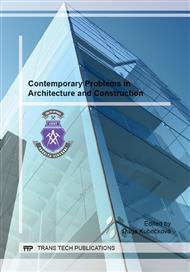p.171
p.177
p.182
p.188
p.193
p.199
p.204
p.210
p.215
The Characterization of Porosity and Frost Resistance of Concrete with Fly Ashes Modified
Abstract:
The paper presents the influence of fly ashes for the parameters which define the characteristics of the air pore and frost resistance of aerated concrete. Concrete which was used in the maximum allowable amount of fly ashes and different amounts of air admixture have been evaluated. Test of concrete mix have been performed such as the slump cone consistency and air content with pressure method used. Compressive strength, the depth of water penetration under pressure, at 150 cycles freeze resistance and the characteristics of the air pores have been evaluated for concrete. Parameters characterizing the pore structure have been marked: the total air content in concrete A, the ratio of pores location L, the content of micropores A300. The results of the study have shown that it is possible to provide good frost resistance of concrete containing fly ashes. Air content of about 4% provides increased resistance to frost well as the use of fly ashes. The condition of frost resistance is to ensure the proper pore structure of the aircraft.
Info:
Periodical:
Pages:
193-198
Citation:
Online since:
October 2014
Authors:
Keywords:
Price:
Сopyright:
© 2014 Trans Tech Publications Ltd. All Rights Reserved
Share:
Citation:


